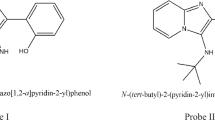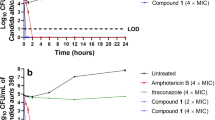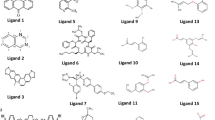Abstract
With the high-frequency use or abuse of antifungal drugs, the crisis of drug-resistant fungi continues to increase worldwide; in particular, the infection of drug-resistant Candida albicans brings the great challenge to the clinical treatment. Therefore, to decelerate the spread of this resistance, it is extremely urgent to facilitate the new antifungal targets with novel drugs. Phosphopantetheinyl transferases PPTases (Ppt2 in Candida albicans) had been identified in bacterium and fungi and mammals, effects as a vital enzyme in the metabolism of organisms in C. albicans. Ppt2 transfers the phosphopantetheinyl group of coenzyme A to the acyl carrier protein Acp1 in mitochondria for the synthesis of lipoic acid that is essential for fungal respiration, so making Ppt2 an ideal target for antifungal drugs. In this study, 110 FDA-approved drugs were utilized to investigate the Ppt2 inhibition against drug-resistant Candida albicans by the improved fluorescence polarization experiments, which have enough druggability and structural variety under the novel strategy of drug repurposing. Thereinto, eight agents revealed the favourable Ppt2 inhibitory activities. Further, broth microdilution assay of incubating C. albicans with these eight drugs showed that pterostilbene, procyanidine, dichlorophen and tea polyphenol had the superior MIC values. In summary, these findings provide more valuable insight into the treatment of drug-resistant C. albicans.


Similar content being viewed by others
References
Lionakis MS (2014) New insights into innate immune control of systemic candidiasis. Med Mycol 52:555–564
Brown GD, Denning DW, Gow NA et al (2012) Hidden killers: human fungal infections. Sci Transl Med 4:165rv113
Smeekens SP, van de Veerdonk FL, Kullberg BJ, Netea MG (2013) Genetic susceptibility to Candida infections. EMBO Mol Med 5:805–813
Ding X, Yan D, Sun W, Zeng Z, Su R, Su J (2015) Epidemiology and risk factors for nosocomial non-Candida albicans candidemia in adult patients at a tertiary care hospital in North China. Med Mycol 53:684–690
Wu JQ, Zhu LP, Ou XT, Xu B, Hu XP, Wang X, Weng XH (2011) Epidemiology and risk factors for non-Candida albicans candidemia in non-neutropenic patients at a Chinese teaching hospital. Med Mycol 49:552–555
Bayhan GI, Garipardic M, Karaman K, Akbayram S (2016) Voriconazole-associated visual disturbances and hallucinations. Cutan Ocul Toxicol 35:80–82
Vollenbroich R, Maeder MT, Weilenmann D (2014) Congestive heart failure related to antifungal therapy with itraconazole. Int J Cardiol 172:e170–e171
Arendrup MC, Fuursted K, Gahrn-Hansen B et al (2008) Semi-national surveillance of fungaemia in Denmark 2004-2006: increasing incidence of fungaemia and numbers of isolates with reduced azole susceptibility. Clin Microbiol Infect 14:487–494
Wang H, Xiao M, Chen SC et al (2012) In vitro susceptibilities of yeast species to fluconazole and voriconazole as determined by the 2010 National China Hospital Invasive Fungal Surveillance Net (CHIF-NET) study. J Clin Microbiol 50:3952–3959
Crawford JM, Vagstad AL, Ehrlich KC, Udwary DW, Townsend CA (2008) Acyl-carrier protein-phosphopantetheinyltransferase partnerships in fungal fatty acid synthases. Chembiochem. 9:1559–1563
Allen G, Bromley M, Kaye SJ, Keszenman-Pereyra D, Zucchi TD, Price J, Birch M, Oliver JD, Turner G (2011) Functional analysis of a mitochondrial phosphopantetheinyl transferase (PPTase) gene pptB in Aspergillus fumigatus. Fungal Genet Biol 48:456–464
Dobb KS, Kaye SJ, Beckmann N, Thain JL, Stateva L, Birch M, Oliver JD (2015) Characterisation of the Candida albicans phosphopantetheinyl transferase Ppt2 as a potential antifungal drug target. PLoS One 10:e0143770
Ashburn TT, Thor KB (2004) Drug repositioning: identifying and developing new uses for existing drugs. Nat Rev Drug Discov 3:673–683
Chong CR, Sullivan DJ Jr (2007) New uses for old drugs. Nature 448:645–646
Zhang JH, Chung TDY, Oldenburg KR (1999) A simple statistical parameter for use in evaluation and validation of high throughput screening assays. J Biomol Screen 4:67–73
Glockner A, Cornely OA (2015) Candida glabrata-unique features and challenges in the clinical management of invasive infections. Mycoses 58:445–450
Phuengkham H, Teeranachaideekul V, Chulasiri M, Nasongkla N (2016) Preparation and optimization of chlorophene-loaded nanospheres as controlled release antimicrobial delivery systems. Pharm Dev Technol 21:8–13
St Georgiev V (2000) Membrane transporters and antifungal drug resistance. Curr Drug Targets 1:261–284
Sanglard D, Ischer F, Koymans L et al (1998) Amino acid substitutions in the cytochrome P-450 lanosterol 14alpha-demethylase (CYP51A1) from azole-resistant Candida albicans clinical isolates contribute to resistance to azole antifungal agents. Antimicrob Agents Chemother 42:241–253
Xiang MJ, Liu JY, Ni PH, Wang S, Shi C, Wei B, Ni YX, Ge HL (2013) Erg11 mutations associated with azole resistance in clinical isolates of Candida albicans. FEMS Yeast Res 13:386–393
Boucher HW, Talbot GH, Benjamin DK, Bradley J, Guidos RJ, Jones RN, Murray BE, Bonomo RA, Gilbert D, for the Infectious Diseases Society of America (2013) Infectious Diseases Society of A: 10 x ‘20 progress-development of new drugs active against gram-negative bacilli: an update from the Infectious Diseases Society of America. Clin Infect Dis 56:1685–1694
Thangamani S, Mohammad H, Younis W, Seleem M (2015) Drug repurposing for the treatment of staphylococcal infections. Curr Pharm Des 21:2089–2100
Yin H, Deng Y, Wang H, Liu W, Zhuang X, Chu W (2015) Tea polyphenols as an antivirulence compound disrupt quorum-sensing regulated pathogenicity of Pseudomonas aeruginosa. Sci Rep 5:16158
Lin HC, Hsieh MJ, Peng CH, Yang SF, Huang CN (2015) Pterostilbene inhibits vascular smooth muscle cells migration and matrix metalloproteinase-2 through modulation of MAPK pathway. J Food Sci 80:H2331–H2335
Huynh HT, Teel RW (2000) Selective induction of apoptosis in human mammary cancer cells (MCF-7) by pycnogenol. Anticancer Res 20:2417–2420
Evensen NA, Braun PC (2009) The effects of tea polyphenols on Candida albicans: inhibition of biofilm formation and proteasome inactivation. Can J Microbiol 55:1033–1039
Sitheeque MA, Panagoda GJ, Yau J et al (2009) Antifungal activity of black tea polyphenols (catechins and theaflavins) against Candida species. Chemotherapy. 55:189–196
Sano A, Uchida R, Saito M et al (2007) Beneficial effects of grape seed extract on malondialdehyde-modified LDL. J Nutr Sci Vitaminol (Tokyo) 53:174–182
La Clair JJ, Foley TL, Schegg TR et al (2004) Manipulation of carrier proteins in antibiotic biosynthesis. Chem Biol 11:195–201
Acknowledgements
The authors thank Shanghai Key Laboratory of New Drug Design, School of Pharmacy, East China University of Science and Technology for kindly providing the clinical drugs. The authors also thank Jiangye Chen of State Key Laboratory of Molecular Biology, Institute of Biochemistry and Cell Biology, Shanghai Institutes for Biological Sciences, Chinese Academy of Sciences for providing strain BWP17.
Funding
This work was financed by grants from the Program of the National Nature Science Foundation of China (#81871706#), the Program of Shanghai Key Specialty (#ZK2012A21) and the Program of Shanghai Municipal Health and Planning Committee (#201740069) and (#201840227).
Author information
Authors and Affiliations
Corresponding authors
Additional information
Responsible Editor: Luis Henrique Souza Guimaraes.
Publisher’s note
Springer Nature remains neutral with regard to jurisdictional claims in published maps and institutional affiliations.
Electronic supplementary material
ESM 1
(DOCX 698 kb)
Rights and permissions
About this article
Cite this article
Meng, LN., Liu, JY., Wang, YT. et al. The discovery of potential phosphopantetheinyl transferase Ppt2 inhibitors against drug-resistant Candida albicans. Braz J Microbiol 51, 1665–1672 (2020). https://doi.org/10.1007/s42770-020-00318-w
Received:
Accepted:
Published:
Issue Date:
DOI: https://doi.org/10.1007/s42770-020-00318-w




